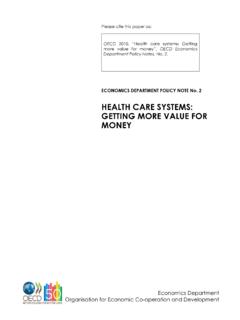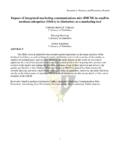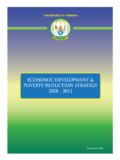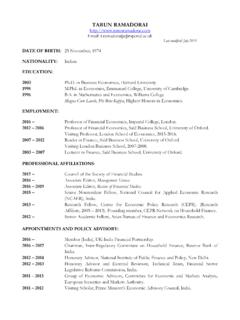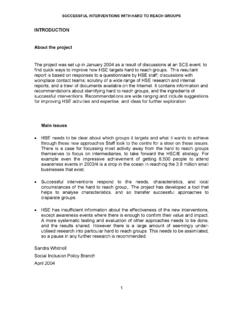Transcription of National Beef - Beef Strategy
1 INVESTING IN A STRONG FUTURE FOR CANADA'S beef INDUSTRY. CANADA'S. National beef Strategy . find the Strategy and learn more at 1. AN OVERVIEW OF. CANADA'S National beef Strategy . The National beef Strategy is about positioning the Canadian beef industry for greater profitability, growth and continued production of a high quality beef product of choice in the world. Why a National beef Strategy ? What is the National beef Strategy ? The Canadian beef industry is at a pivotal point in time. The Strategy presents priorities, goals and funding needs to We are facing new challenges and opportunities with strong ensure the Canadian beef industry thrives well into the future, influences on the supply and demand of Canadian beef . while building on the strengths of existing industry organizations. Demand for high quality protein is expected to continue to The Strategy is structured around four pillars and goals that grow in most developing nations.
2 The majority of markets are aligned with the industry's vision of being dynamic and closed due to BSE have been reopened, and a number of profitable, and its mission to be the most trusted and competitive new trade agreements are coming into effect providing new high quality beef cattle producer in the world, recognized opportunities for Canada's beef industry. for superior quality, safety, value, innovation and sustainable production methods. Cattle numbers are down across much of the world. Canada experienced one of the largest liquidation phases in history The pillars and goals of the National beef Strategy are: with beef cow inventories dropping by 30% between 2005. and 2015. beef Demand Increase carcass cutout value by 15% by 2020. Normally the current record high cattle prices would compel Competitiveness Reduce cost a strong and rapid expansion, however there is greater disadvantages compared to main competition for acreage and expansion is expected to be competitors by 7% by 2020.
3 Slower than we have seen in previous cattle cycles. Productivity Increase production Industry funding is challenged due to reduced cattle efficiency by 15% by 2020. marketings and check-off collections, inflation and expiration of Connectivity Enhance synergies government development funds. within industry and connect Consumers are increasingly concerned about production positively with consumers, practices and impacts, such as environmental stewardship, the public, government, animal welfare and sustainability. and partner industries Canada has an abundance of natural resources, and the finest beef cattle and beef cattle producers in the world. Combine that with the focus and ambition of a National Strategy , and the industry can be positioned to take advantage of great opportunity. Competitiveness beef Demand Connectivity Productivity The National beef Strategy was developed in 2014 by industry leaders representing Canada's National and provincial beef sector organizations.
4 beef Cattle Research Council, Canadian beef Breeds Council, Canada beef , Canadian Cattlemen's Association and its provincial member associations, and National Cattle Feeders' Association. PILLAR ONE. I. beef DEMAND. Increase carcass cutout value by 15% by 2020. Highlights of the outcomes under the beef Demand pillar: A. The industry will remain competitive by getting the right product We have to work together across the beef to the right customer every time, often achieved through supply chain to create and sustain loyalty product development and the use of under-valued cuts. to our product by focusing strategically on our domestic and international customers B. The core attributes of the Canadian beef Advantage (CBA). and consumers. To make that happen we and how they influence sales volumes and values require must tell our story in meaningful ways, continuous validation and improvement all of which drive to the right audience, and create brand consumer confidence.
5 The Strategy works to establish the ambassadors for Canadian beef .. CBA as the most recognized and loyalty-based beef brand in Jack Hextall | Saskatchewan beef producer and Chair, Canada beef the world. D. Consumers have more choice than ever on how to spend C. Over 40% of Canadian beef production is exported. Canada their food dollars. When people feel good and are confident will continue to undertake the most ambitious trade agenda about a product they will buy it more often. Consumer in the world as trade agreements are essential to ensure confidence, impacted by food safety, food quality and Canada has commercially viable access as compared to other production practices, is essential to maintain current major beef exporters. customers and attract new ones. Regular audits at the processor and consumer levels provide the information necessary to validate and enhance the Each animal we raise will be quality and safety of Canadian beef while processed into more than 300.
6 Increasing the profitability of the Canadian products; exporting products beef and cattle industry.. that are in greater demand Jennifer MacDonald | New Brunswick beef producer and outside Canada can add over Chair, Maritime beef Council $400 in value per animal. E. The social license to operate in agriculture is becoming increasingly visible in the media and continues to generate interest with the general public. The Canadian beef industry's Increase in international demand science-based approach and overall benefits need to be for Canadian beef conveyed through various means. 2010 vs 2014. AAA Cutout Values 38 % 2001 vs 2014. $ 29%. INCREASE. $ FROM PREVIOUS. PEAK IN 2001. 2006 $ 19%. 2014 2001 2014 30%. find the Strategy and learn more at 3. PILLAR TWO. II. COMPETITIVENESS. Reduce cost disadvantages compared to main competitors by 7% by 2020.
7 Participating in international events such as the Five Nations beef Alliance, with representation from cattle producer leaders in Canada, the , Mexico, Australia and New Zealand, provides the forum for open discussion on shared opportunities and challenges faced by beef producers around the world.. Martin Unrau | Manitoba beef producer and Co-Chair, National beef Strategic Planning Group The development of free trade agreements and reduction of market access restrictions can involve a tremendous amount of industry and government time and effort. The cumulative cost of COOL from 2009- 2013 is estimated at $830 million.. Dan Darling | Ontario beef producer and Vice President, Canadian Cattlemen's Association Highlights of the outcomes under the Competitiveness pillar: A. To be competitive, it is necessary to have a regulatory system that supports the industry, encourages innovation and efficiency, and doesn't add unnecessary burden or costs.
8 The Strategy advocates and upholds a scientific based regulatory system in cooperation with trading partners. 1950's feed efficiency was 10:1. B. All industries must have access to competitively priced inputs in order Today it's 6:1. to be profitable the beef industry is no exception. It is imperative that the Canadian business environment supports the development of new innovative inputs that can reduce production costs. C. Research funding, infrastructure, and human capital have declined significantly in recent decades. It's important to maintain scientific expertise and infrastructure in order to respond to issues as they emerge and to facilitate the transition of research programs and corporate memory. D. Consumers are increasingly demanding food that is produced in a Each day grazing is extended, sustainable manner and Canada must be at the table when discussing the cow-calf sector the environmental, social, and economic sustainability priorities with beef saves $ million.
9 Leaders around the world. The Strategy will provide the research and information for factual and science-based communication. Source: Canfax Research Services find the Strategy and learn more at 4. PILLAR THREE. III. PRODUCTIVITY. Increase production efficiency by 15% by 2020. Increase in Decrease in forage production cost of production at 30 % cow-calf level RESULTS IN. 15 %. Source: Canfax Research Services Highlights of the outcomes under the Productivity pillar: A. Productivity is the key part of the Strategy where the producer As an industry we need to increase is in the driver's seat. The Strategy is focused on enhancing the number of producers adopting new producer investment and adoption of innovation on individual technology, and reduce the lag time from operations to result in improvements in productivity. development to adoption.
10 Ryan Beierbach | Saskatchewan beef producer and B. Research will lead to innovative technologies and knowledge, beef Cattle Research Council member and the continued competitiveness and sustainability of Canada's beef industry. The Strategy is focused on making D. The Strategy will work to support breeding and targeted investments in priority research in the areas of beef management decisions made by seedstock and cow-calf quality and safety, genetic improvement, animal health and producers that positively impact animal performance in the welfare, feed efficiency, and feed and forage production. feedlot, yield and quality grade at the packing plant, and the consumer eating experience. C. Knowledge dissemination and technology transfer are critical to realize the economic, environmental and social benefits It is important to facilitate the transfer of of investments in beef research.

